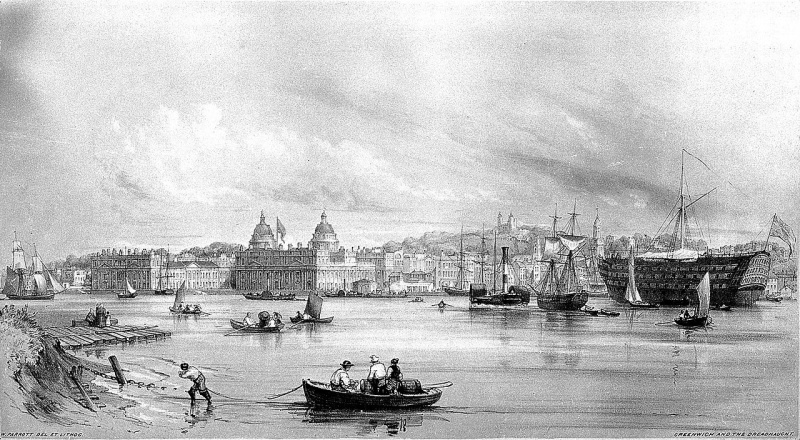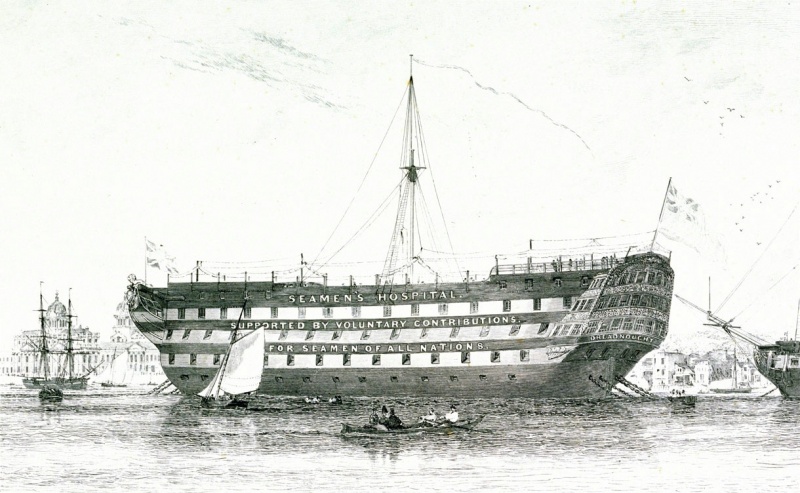HMS Dreadnought (1801)
HMS Dreadnought was a 98-gun second rate. Designed by Sir John Henslow, and built by M/S George White, then Edward Tippett and completed by Henry Peake. This ship of the line was launched at Portsmouth at midday on Saturday, 13 June 1801, after she had spent 13 years on the stocks. She was the first man-of-war launched since the Act of Union 1800 created the United Kingdom of Great Britain and Ireland, and at her head displayed a lion couchant on a scroll bearing the Royal arms as emblazoned on the Standard.
Launch.
After the launch, Dreadnought was brought into dock for coppering, and a great number of people went on board to view her. The following day, due to the exertions of Mr Peake, the builder, and the artificers of the dockyard, she was completely coppered in six hours and on Monday morning she went out of dock for rigging and fitting.
History
GREAT BRITAIN
Name:
HMS Dreadnought
Ordered:
17 January 1788
Builder:
Portsmouth Dockyard
Laid down:
July 1788
Launched:
13 June 1801
Fate:
Broken up, 1857
Notes:
- Participated in:
- Battle of Trafalgar
General characteristics
Class and type:
Neptune-classship of the line
Tons burthen:
2110 (bm)
Length:
185 ft (56 m) (gundeck)
Beam:
51 ft (16 m)
Depth of hold:
21 ft (6.4 m)
Propulsion:
Sails
Sail plan:
Full rigged ship
Armament:
- Gundeck: 28 × 32-pounder guns
- Middle gundeck: 30 × 18-pounder guns
- Upper gundeck: 30 × 18-pounder guns
- Quarterdeck: 8 × 12-pounder guns
- Forecastle: 2 × 12-pounder guns
Active service.
Her first commander was Captain James Vashon. After cruising for some time in the Channel he proceeded off Cádiz and Menorca where he continued until the summer of 1802.
In the April of 1803 she was briefly Captained by James Bowen, but from May Captain Edward Brace briefly took command as flag captain to William Cornwallis, and then William Dommett in July, until he in turn was relieved in the September of that year by Captain John Child Purvis. Purvis served under the orders of Admiral Cornwallis for the blockade of Brest until the latter was promoted to rear-admiral in the April of 1804. The next commander from The May of 1804 until August was George Reynolds., who, in turn, was replaced in the January of 1805 by Edward Rotheram, who stayed as flag captain to Admiral Cuthbert Collingwood in the Channel Fleet until just before Trafalgar. The winter gale weather off the French coast badly damaged five of the major warships maintaining the blockade. Dreadnought lost most of her powder when water poured into her magazine.
In the spring of 1805, Admiral Cornwallis was superseded by the ailing Lord Gardner who allowed the close blockade to be slackened due to adverse weather conditions. On the 30th of March the French fleet slipped out of Toulon and sailed for Cádiz reaching it on the 9th of April. The French and Spanish squadrons then sailed separately from there and re-joined forces at Martinique on the 26th of May with Admiral Nelson in close persuit. On the15th of May, Collingwood and his squadron of seven ships received orders from the Admiralty to sail for Barbados. Before they could depart; however, Horatio Nelson arrived still in pursuit of the French, and Dreadnought proceeded to Cádiz to allow Collingwood to establish a close blockade of that Naval base.
Early in the October of 1805 Captain John Conn assumed command of Dreadnought, after having brought Royal Sovereign out from England for Vice-Admiral Collingwood. Collingwood and Rotheram then moved to the newly recoppered first rate on 10 October 1805, leaving Conn in command of the now sluggish Dreadnought, with her barnacled hull badly in need of careening, but nevertheless with a well exercised ship's company, who for months having been under Collingwood's watchful eye, now contained one of the most efficient gun crews in the fleet.
At the battle of Trafalgar on the 21st of October, 1805, Dreadnought was the eighth ship in the lee division to enter the action. She started firing on San Juan Nepomuceno at two o'clock and fifteen minutes later ran her on board and forced her to surrender after her commander Commodore Cosme Damian de Churruca y Elorza had been killed in action. She then attempted to engage Principe de Asturias but the Spanish ship hauled off. During the battle Dreadnought lost seven killed and 26 wounded.
After Trafalgar, Dreadnought continued in the blockade of Cadiz. On 25 November, Thunderer detained the Ragusan ship Nemesis, which was sailing from Isle de France to Leghorn, Italy, with a cargo of spice, indigo dye, and other goods. Dreadnought shared the prize money with ten other British warships.
In the September of 1806 she was ordered to Portsmouth for a refit. She was recommissioned in the December of that year, under the Captaincy of William Lechmere, for service in the Channel. She remained as part of the Channel Fleet, from that date until 1809.From 1808 she was under Captain G. B. Salt serving as the flagship of Rear-Admiral Thomas Sotheby, off Ushant.
On 9 November Dreadnought, Gibraltar, Christian VII, Milford, Naiad, Unicorn, and the hired armed cutters Nimrod and Adrian were all in sight when the Ballahoo class schoonerSnapper captured the French brig Modeste.
In 1810, still under Sotheby, she had another change of Captin to Samuel Linzee. On 7 September of that year, the Snapper sighted a ship among the rocks on the west side of Ushant. She made a signal to Dreadnought, who carried off a cutting out expedition which culminated in the taking of the Spanish merchant brig Maria-Antonia, which had previously been captured by a French privateer. However, the success was bought at the cost of six dead, 31 wounded, and a further six men missing, in addition to two ship’s boats. This was as a result of an ambush by a large party of French troops with two field pieces positioned upon a cliff overlooking the anchorage.
In the spring of 1811, Dreadnought, under Captain Samuel Linzee, was berthed in Lisbon from whence she was ordered to the Baltic at the end of that year. On the 16th of December, 1811, a fleet of about 150 merchant ships sailed from Wingo, near Gothenburg, under the escort of a number of ships, including Dreadnought. A gale resulted in the loss of St George and Defence as previously mentioned in the Article about the former Providently, Dreadnought and the other ships survived to arrive safely at their destination.
Paid of at Portsmouth in December of that year Dreadnought underwent large repairs not completed until the August of 1812. She then went into Ordinary.
Fate.
In 1825 she was fitted out as a Lazarett to berth at Pembroke. Next fitted as a Hospital ship at Sheerness in mid 1831, she was then moved to Woolwich.She became the second of the ships used by the Seamen's Hospital Society, from this date until 1857, as a hospital ship for ex-members of the Merchant Navy or fishing fleet, and their dependents.

Dreadnought at Greenwich 1841 by William Parrott
https://wellcomeimages.org/indexplus...4b.jpgGallery:

Dreadnought as a Quarantine ship.
Dreadnought was finally broken up in 1857.








Bookmarks